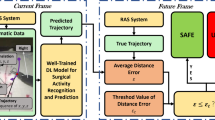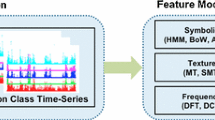Abstract
Purpose
In robotic-assisted surgical training, the expertise of surgeons in maneuvering surgical instruments may be utilized to provide the motion trajectories for teaching. However, the motion primitives for trajectory planning are not known until the motion trajectory is generalized. We hypothesize that a generic model that encodes surgical skills using demonstrations and statistical models can be used by the surgical training robot to determine the motion primitive base on the motion trajectory.
Methods
The generic model was developed from twenty-two sets of motion trajectories of soft tissue division with laparoscopic scissors collected from a robotic laparoscopic surgical training system. Adaptive mean shift method with initial bandwidth determined by the plug-in-rule method was used to identify the primitives in the motion trajectories. Gaussian Mixture Model was applied to model the underlying motion structure. Gaussian Mixture Regression was then applied to reconstruct a generic motion trajectory for the task.
Results
The generic model and proposed method were investigated in experiments. Motion trajectory of tissue division was model and reconstructed. The motion model which was trained based on primitives determined by adaptive mean shift method produced RMS error of \(3.05^{\circ }\) and \(3.08^{\circ }\) with respect to the demonstrated trajectories of left and right instruments, respectively. The RMS error was smaller than that of k-means method and fixed bandwidth mean shift method. The dexterous features in the demonstrations were also preserved.
Conclusions
Surgical tasks can be modeled using Gaussian Mixture Model and motion primitives identified by adaptive mean shift method with minimum user intervention. Generic motion trajectory has been successfully reconstructed based on the motion model. Investigation on the effectiveness of this method and generic model for surgical training is ongoing.











Similar content being viewed by others
References
Winer J, Can MF, Bartlett DL, Zeh HJ, Zureikat AH (2012) The current state of robotic-assisted pancreatic surgery. Nat Rev Gastroenterol Hepatol. doi:10.1038/nrgastro.2012.120
Kwartowitz D, Herrell SD, Galloway R (2006) Toward image-guided robotic surgery: determining intrinsic accuracy of the da Vinci robot. Int J Comput Assist Radiol Surg 1(3):157–165. doi:10.1007/s11548-006-0047-3
Murphy DG, Hall R, Tong R, Goel R, Costello AJ (2008) Robotic technology in surgery: current status in 2008. ANZ J Surg 78(12):1076–1081. doi:10.1111/j.1445-2197.2008.04754.x
Liu J, Cramer SC, Reinkensmeyer DJ (2006) Learning to perform a new movement with robotic assistance: comparison of haptic guidance and visual demonstration. J Neuroeng Rehabil 3:20. doi:10.1186/1743-0003-3-20
Schaal S (1999) Is imitation learning the route to humanoid robots? Trends Cogn Sci 3(6):233–242
Argall BD, Chernova S, Veloso M, Browning B (2009) A survey of robot learning from demonstration. Rob Auton Syst 57(5):469–483. doi:10.1016/j.robot.2008.10.024
Inamura T, Kojo N, Sonoda T, Sakamoto K, Okada K, Inaba M (2005) Intent imitation using wearable motion capturing system with on-line teaching of task attention. In: 5th IEEE-RAS international conference on humanoid robots, December 5–5 2005, pp 469–474. doi:10.1109/ichr.2005.1573611
Calinon S, Guenter F, Billard A (2007) On learning, representing, and generalizing a task in a humanoid robot. IEEE Trans Syst Man Cybern Part B Cybern 37(2):286–298
Yamane K, Yamaguchi Y, Nakamura Y (2011) Human motion database with a binary tree and node transition graphs. Auton Robots 30(1):87–98
Reiley CE, Plaku E, Hager GD (2010) Motion generation of robotic surgical tasks: learning from expert demonstrations. In: 2010 annual international conference of the IEEE engineering in medicine and biology society (EMBC), August 31 2010–September 4 2010, pp 967–970
Niessen W, Viergever M, Thakral A, Wallace J, Tomlin D, Seth N, Thakor N (2001) Surgical motion adaptive robotic technology (S.M.A.R.T): taking the motion out of physiological motion. In: Medical Image Computing and Computer-Assisted Intervention – MICCAI 2001, vol 2208. Lecture Notes in Computer Science. Springer, Berlin Heidelberg, pp 317–325. doi:10.1007/3-540-45468-3_38
Pagador JB, Sanchez-Margallo FM, Sanchez-Peralta LF, Sanchez-Margallo JA, Moyano-Cuevas JL, Enciso-Sanz S, Uson-Gargallo J, Moreno J (2011) Decomposition and analysis of laparoscopic suturing task using tool-motion analysis (TMA): improving the objective assessment. Int J Comput Assist Radiol Surg 7(2):305–313. doi:10.1007/s11548-011-0650-9
Lin HC, Shafran I, Yuh D, Hager GD (2006) Towards automatic skill evaluation: detection and segmentation of robot-assisted surgical motions. Comput Aided Surg 11(5):220–230. doi:10.3109/10929080600989189
Hermann M, Faustino G, Daan W, Istvan N, Alois K, Jurgen S (2006) A system for robotic heart surgery that learns to tie knots using recurrent neural networks. In: IEEE/RSJ international conference on intelligent robots and systems, October 2006, pp 543–548. doi:10.1109/iros.2006.282190
Peters J, Schaal S (2008) Reinforcement learning of motor skills with policy gradients. Neural Netw 21(4):682–697. doi:10.1016/j.neunet.2008.02.003
Kober J, Peters J (2010) Imitation and reinforcement learning. IEEE Robot Autom Mag 17(2):55–62. doi:10.1109/mra.2010.936952
Kormushev P, Calinon S, Caldwell DG (2010) Robot motor skill coordination with EM-based reinforcement learning. In: IEEE/RSJ international conference on intelligent robots and systems (IROS), 18–22 October 2010. pp 3232–3237. doi:10.1109/iros.2010.5649089
Thobbi A, Weihua S (2010) Imitation learning of hand gestures and its evaluation for humanoid robots. In: IEEE international conference on information and automation (ICIA), 20–23 June 2010. pp 60–65. doi:10.1109/icinfa.2010.5512333
Reiley CE, Lin HC, Varadarajan B, Vagvolgyi B, Khudanpur S, Yuh DD, Hager GD (2008) Automatic recognition of surgical motions using statistical modeling for capturing variability. Stud Health Technol Inform 132:396–401
Sheather SJ, Jones MC (1991) A reliable data-based bandwidth selection method for kernel density estimation. J R Stat Soc 53(3):683–690. doi:10.2307/2345597
Mugdadi AR, Ahmad IA (2004) A bandwidth selection for kernel density estimation of functions of random variables. Comput Stat Data Anal 47(1):49–62
Horová I, Kolácek J, Zelinka J, Vopatová K (2008) Bandwidth choice for kernel density estimates. In: 6th conference of the asian regional section of the IASC, Yokohama Japan
Wand MP, Jones MC (1995) Kernel smoothing. Monographs on statistics and applied probability 60. Chapman & Hall, Londong
Comaniciu D, Ramesh V, Meer P (2001) The variable bandwidth mean shift and data-driven scale selection. In: 8th IEEE international conference on computer vision, vol 431, pp 438–445
Horová I, Kolácek J, Vopatová K, Full bandwidth matrix selectors for gradient kernel density estimate. Comput Stat Data Anal 57 (1):364–376
Rabiner L, Juang B (1986) An introduction to hidden Markov models. IEEE ASSP Mag 3(1):4–16. doi:10.1109/massp.1986.1165342
Yang T, Liu J, Huang W, Su Y, Yang L, Chui C, Ang M, Jr., Chang SY (2012) Mechanism of a learning robot manipulator for laparoscopic surgical training. In: Intelligent autonomous systems 12, vol 194. Advances in Intelligent Systems and Computing. Springer, Berlin Heidelberg, pp 17–26. doi:10.1007/978-3-642-33932-5_3
Calinon S, D’Halluin F, Sauser EL, Caldwell DG, Billard AG Learning and reproduction of gestures by imitation. Rob Autom Mag IEEE 17(2):44–54. doi:10.1109/mra.2010.936947
Acknowledgments
This work is partially supported by research Grant BEP 102 148 0009, Image-guided Robotic Assisted Surgical Training from the Agency for Science, Technology and Research, Singapore.
Conflict of interest
All authors declare that they have no conflicts of interest.
Author information
Authors and Affiliations
Corresponding author
Rights and permissions
About this article
Cite this article
Yang, T., Chui, C.K., Liu, J. et al. Robotic learning of motion using demonstrations and statistical models for surgical simulation. Int J CARS 9, 813–823 (2014). https://doi.org/10.1007/s11548-013-0967-7
Received:
Accepted:
Published:
Issue Date:
DOI: https://doi.org/10.1007/s11548-013-0967-7




